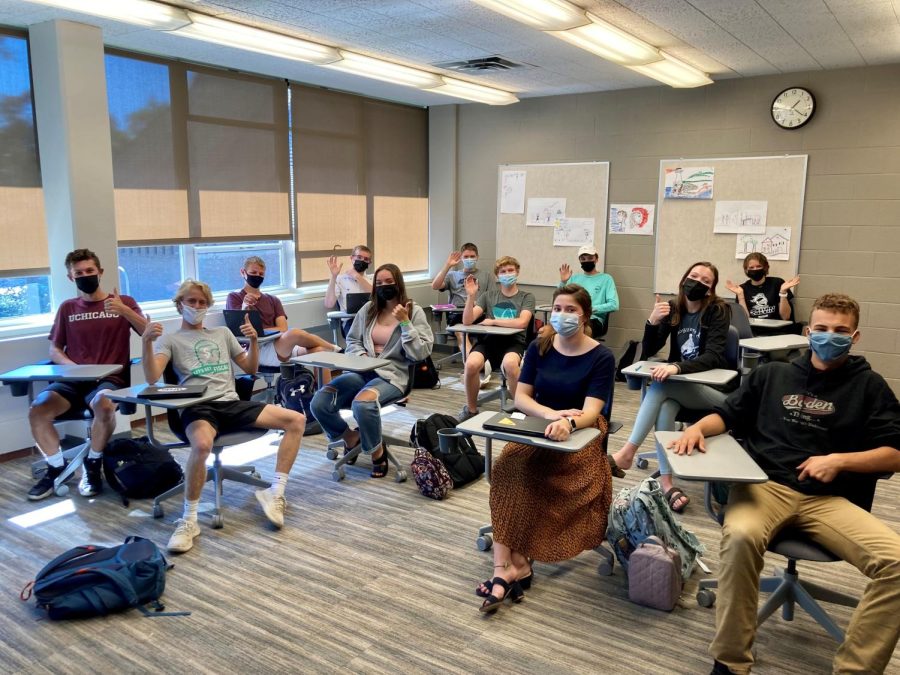Dual enrollment, language immersion programs bridge gap between campus and local schools
To be eligible for the Spanish Immersion Program, students must have attended a Spanish Immersion program since elementary school.
Nearly 100 dual-enrolled high school students are attending classes at Calvin this fall, including students in the Spanish Immersion program, which is now in its second year.
Each year, the university admits high school juniors and seniors in its dual enrollment program. Emily Annett, assistant director of admissions and dual enrollment, told Chimes that through the program, students attend in-person classes and work on projects the same way full-time students would.
Admitted juniors or seniors in high school choose from a wide range of courses available at Calvin; the most popular ones include mathematics or statistics, psychology, world languages and political science, according to Annett.
Most dual-enrolled students come from local high schools within about an hour of Calvin’s campus, according to Annett. Students taking more than six credits on campus follow the same COVID-19 requirements as full-time students; all unvaccinated students are required to be tested weekly.
“Dual enrolling not only allows high school students to get a jump-start on college courses, but also gives them the feel for a collegiate community,” Annett said.
Half of the dual-enrolled students are in the Spanish Immersion program, which began in the fall of 2020 and aims at expanding this sense of community.
Professor Dwight TenHuisen from the Spanish department told Chimes that the immersion program is “a two-year program designed for [high school students] to come together to take courses at Calvin and earn Calvin credit” with the goal of graduating from high school with a minor in Spanish at Calvin.
To be admitted in the program, students must come from Spanish Immersion schools they have attended since elementary school, and are required to take the Spanish Advanced Placement exam in their sophomore year. Once enrolled, they are required to take four Spanish classes at Calvin, most of them with full-time students pursuing a Spanish major or minor. To fulfill the minor, students also need to complete an off-campus experience of at least three weeks through one of Calvin’s semester abroad programs in Mexico, Peru, Honduras or Spain.
The program started as a response to a request from Grandville Calvin Christian High and Grand Rapids Christian High to partner with Calvin. This year, Calvin is partnering with three more local schools.
“Last year, we started with 12 students from Grandville Calvin Christian and this year we have added 33 students, for a total of 45,” said Nora Koster, Spanish Immersion program coordinator.
While students are free to choose from a variety of classes, they are all required to take Spanish 300 as their first class, designed specifically for students in the immersion program. The course focuses on improving the students’ academic level in Spanish by engaging with scholarly material from a wide array of Hispanic authors, including the accounts of Afro-Latino and Indigenous authors.
Professor Abraham Ceballos, who teaches the class, said, “This is one building block towards preparing them to be able to be successful in the rest of courses here at Calvin. And it’s also a bridge between what they’re doing in Spanish in their high schools, and then the type of Spanish required at a college level.”
High school senior Brady Nichols is one of the dual-enrolled students in the immersion program. “For the most part it’s been easy to get acclimated and comfortable, and the professors and staff on Calvin University’s end have been very helpful,” Nichols said. “Our classes have been challenging but manageable, the material has been presented in a different style compared to our high school classes, so it’s been some good college prep as well. I’m happy with how it’s turned out so far.”
Melissa Scholten, another student in the program, said she’s also grateful for the experience she’s had. “Although these courses have been very challenging, I feel as though I have improved my Spanish greatly and my understanding and appreciation of Spanish culture,” she told Chimes.
Koster said the program gives students a greater appreciation of other cultures through the study of the Hispanic culture. According to her, one of the benefits of the program is “not just knowing about it but understanding and accepting better what other cultures bring to their lives and how they can also bring something to other cultures as well.”







Amanda Scholten • Oct 7, 2021 at 9:31 pm
Wonderful article highlighting an excellent program!